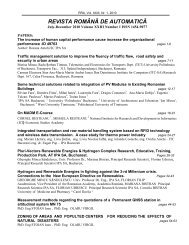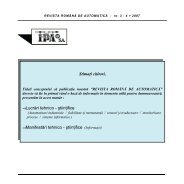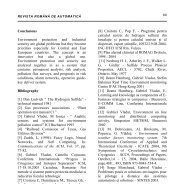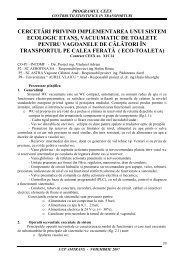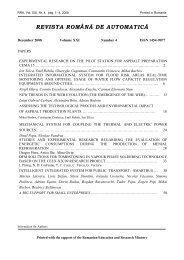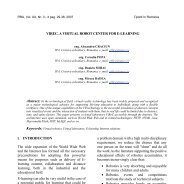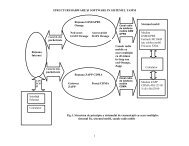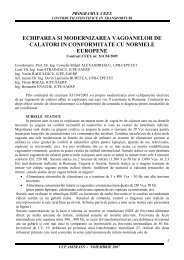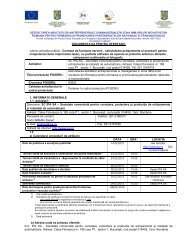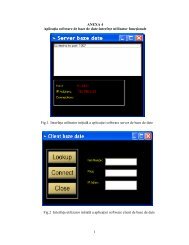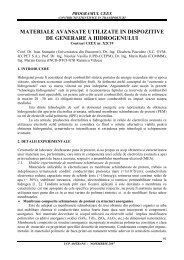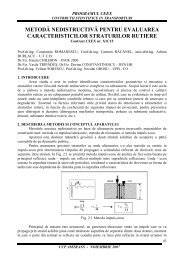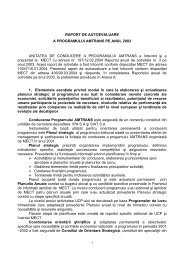Elementele componente ale reţelei Petri: Locaţii: P1 ... - IPA SA
Elementele componente ale reţelei Petri: Locaţii: P1 ... - IPA SA
Elementele componente ale reţelei Petri: Locaţii: P1 ... - IPA SA
You also want an ePaper? Increase the reach of your titles
YUMPU automatically turns print PDFs into web optimized ePapers that Google loves.
REVISTA ROMÂN DE AUTOMATIC<br />
111<br />
• Part 4: Test cycles for different engine<br />
applications;<br />
• Part 5: Test fuels;<br />
• Part 6: Test report;<br />
• Part 7: Engine family determination;<br />
• Part 8: Engine group determination;<br />
• Part 9: Test-bed measurement of exhaust<br />
gas smoke emissions from engines used in<br />
non-road mobile machinery.<br />
For in-service waterway engine testing, the most<br />
important parts of ISO 8178 are Parts 2 and 4.<br />
These parts specify theoretical conditions and<br />
test cycles to in-service engine testing.<br />
Although exists this standard, it is difficult to<br />
respect its conditions for on-board measurements.<br />
These measurements are generally adapted to<br />
the real conditions, so that the ship can<br />
execute its activities without changes.<br />
For such measurements were published<br />
different work manuals and guides that are<br />
based on ISO 8178 but with modifications for<br />
on-board conditions.<br />
2.2 Mass balance<br />
The mass balance identifies the quantity of<br />
substance going in and out of the process.<br />
Emission factors can be calculated as the<br />
difference between input and output of each<br />
substance present in process.<br />
These techniques are best applied to systems<br />
with prescribed inputs, defined internal<br />
conditions, and known outputs. This method<br />
is recommended to be used in calculation of<br />
exhaust gas flow and/or combustion air<br />
consumption: “Carbon balance method” and<br />
“Carbon/oxygen balance”.<br />
Both methods are based on exhaust gas<br />
concentration measurements and on knowledge<br />
of fuel consumption and composition. The both<br />
methods are described in TECHNICAL<br />
CODE ON CONTROL OF EMISSION OF<br />
NITROGEN OXIDES FROM MARINE<br />
DIESEL ENGINES, MP/CONF. 3/35,<br />
adopted on Sept. 1997 by the Conference of<br />
Parties to the International Convention for the<br />
Prevention of Pollution from Ships.[5]<br />
2.3. Engineering calculation<br />
An engineering calculation is an estimation<br />
method based on physical/chemical<br />
properties of the substances and mathematical<br />
relationships.<br />
Theoretical and complex equations or models<br />
can be used for estimating emission factor<br />
from a variety of waterway activities and<br />
processes.<br />
Use of engineering calculations to estimate<br />
emission factor from such activities can be a<br />
more complex and time-consuming process.<br />
2.4. Associated method for estimation of<br />
emission factors<br />
This method is a combination of the first<br />
three methods and is based on developing a<br />
correlation between pollutant emission rates<br />
and process parameters through<br />
measurements, information from databases or<br />
statistic and calculation.<br />
This method allows the development of<br />
specific emission factors, or emission factors<br />
more relevant for particular process stages.<br />
Based on test data and using various<br />
parameters, a mathematical correlation can be<br />
developed to establish emission factors<br />
relevant for the process.<br />
In this case it is necessary to outline the<br />
techniques for determination of emission<br />
factors of pollutant substances from the<br />
principal operational activities considered<br />
major in the navigation process, to establish<br />
the data inputs required, and the sources of<br />
this data.<br />
These calculations are based on standard<br />
assumptions about vessel operations, engine load<br />
profiles, and emissions characteristics. It is<br />
widely acknowledged that in-service engines<br />
perform differently than the new engines tested<br />
and certified by manufacturers.<br />
We mention here reference [2], VESSEL<br />
OPERATOR ENGINE EMISSIONS<br />
MEASUREMENT GUIDE, Final Report,<br />
Submitted by James J. Corbett, P.E., Ph.D.,<br />
Principal Investigator University of Delaware<br />
(may 2003).



